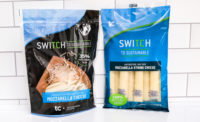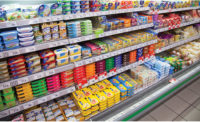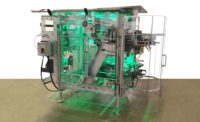The dairy packaging sector feels the heat
Aseptic and retort packaging are becoming more popular and potent forces in the war against pathogens.

Pulsed-light systems offer dry, chemical-free decontamination without consuming water or generating toxic effluents. Photo courtesy of Serac Inc.

Processors should consider such factors as product type, desired shelf life, and thermal treatment application when selecting decontamination technologies. Photo courtesy of GEA Group

Advanced technologies can support a range of dairy products with differing viscosities. Photo courtesy of JCS Process & Control Systems

Product characteristics, including acidity levels and targeted shelf life, can influence packaging system choice. Photo courtesy of Sidel

Operators stir the fluids in dairy packaging during agitation retorts to reduce the chance of burning. Photo courtesy of Allpax Products LLC

Sustainable packaging material is becoming increasingly prominent in dairy processing. Photo courtesy of IMA Dairy & Food USA Inc.






Dairy packaging is playing an increasingly significant role in enhancing food safety and shelf life. Indeed, rising demand for packaging that can prevent microbial contamination is resulting in innovative designs and greater category activity.
The North American aseptic packaging market, for instance, is forecast to increase from $9.5 billion in 2020 to $14.2 billion by 2026, with a compound annual growth rate (CAGR) of 6.5% during the period, projects Mordor Intelligence, a Hyderabad, India-based market intelligence and advisory firm.
“There is an increasing demand for aseptic packaging identified in the region’s dairy market,” Mordor Intelligence states. “The increasing production and export of milk, especially in the United States, is expected to open new market opportunities in the region.”
Aseptic packaging uses a process in which operators prevent microorganisms from entering a package during and after packaging. During aseptic processing, operators fill a sterilized package with a commercially sterile food product and seal it within the confines of a hygienic environment. Sterilization of the food or beverage occurs with quick exposure to ultra-high heat, before rapidly cooling at an ambient temperature.
There are no health concerns associated with aseptic packaging, FDA states, noting that the inside layer of an aseptic package that touches the product is polyethylene (plastic).
“There is no leaching of aluminum or aluminum components through the polyethylene layer,” FDA states. “It is the only material in the package that comes in contact with the food product. In addition, industry tests have shown that no polyethylene leaches into the food product.”
Aseptic packaging can include rigid containers such as metal cans, glass bottles, and jars; paperboard containers consisting of paper, foil, plastic and preformed cartons; semi-rigid plastic containers such as preformed cups, tubs, trays, and bottles; and flexible plastic containers such as pouches.
Mordor Intelligence notes that advancements in packaging materials and production processes are resulting in longer product shelf lives. Elements include increasingly popular ultraviolet and pulsed light, which “provides very good sterilization and lower operating costs for the producer,” says Patrick Carroll, president of IMA Dairy & Food USA, a Leominster, Mass.-based supplier of packaging machinery, technology, and services.
Pulsed-light systems use high-intensity pulsed broad-spectrum light, which flashes several times per second to destroy microbes. The systems also enhance sustainability by offering dry, chemical-free decontamination without consuming water or generating toxic effluents, says Jean-Luc Hostachy, technical director for Serac Inc., a Carol Stream, Ill.-based packaging machine manufacturer. The technology kills microorganisms through the destruction of their cell membrane and DNA breakdown, he notes.
Yogurt manufactures are among the dairy product producers incorporating more aseptic packaging, Mordor Intelligence states, noting that yogurt is in greater demand as more consumers seek healthier foods.
“Aseptic packaging keeps yogurt safe and fresh from fill through final dispensing,” the firm notes. “Bag-in-box and pouches protect the quality, extend freshness and reduce waste. With aseptic technology, yogurt products are shelf-stable and preservative-free.”
An emphasis on eco
While technological enhancements are enabling processors to better safeguard products, packaging with sustainable elements also is becoming increasingly important as consumers become more eco-conscious, says Massimo Nascimbeni, blowing and filling product manager for GEA Group, a provider of aseptic bottling and cheese packaging machinery with North American headquarters in Columbia, Md.
“Dairy manufacturers can find improvements in carbon-footprint reductions by reconsidering conventional packaging concepts,” he states, which includes reducing the amount of packaging materials and using recycled matter.
“There is a lot of pressure on sustainability in the market,” Carroll adds. “Processors should make sure the equipment they purchase can handle the latest eco-conscious materials such as PET.”
Polyethylene terephthalate (PET) is a form of polyester that users extrude or mold into plastic bottles and containers for packaging foods and beverages. The New York-based PET Resin Association reports that about 1.5 billion pounds of used PET bottles and containers are recovered in the United States each year for recycling, making it the most recycled plastic in America.
While the dairy sector is moving to more sustainable packaging, operators still face the challenge of incorporating relevant elements into designs while extending product shelf life and controlling packaging costs, says Todd Delebreau, vice president of sales for Hart Design & Manufacturing Inc., a Green Bay, Wis.-based provider of packaging and processing equipment. He notes, for instance, that older, antiquated equipment often cannot run new sealants or sustainable films at current speeds.
Pinpoint the optimal option
In choosing the ideal aseptic packaging and machinery, processors should consider the characteristics of the products under production, says Luis Arbona, technical sales manager, sensitive products, for Sidel, a Parma, Italy-based provider of packaging equipment and services. That can include physicochemical properties such as viscosity, acidity levels, targeted shelf life, and whether products will go through a chilled or ambient distribution channel, he notes.
Operators also must determine if the packaging will withstand the abuse it may receive in the distribution chain, as well as if it will stand out from those of competitors, says Yamille Mendieta, marketing manager for JCS Process & Control Systems, a Rochester, N.Y.-based provider of technologies that support aseptic and extended-shelf-life processing.
For best results, operators should team with equipment suppliers to develop and implement technologies that emphasize hygiene, efficiency, and productivity, Hostachy states, adding that the parties should pay close attention to packaging decontamination and clean-in-place capabilities.
“Risks and requirements vary with the microbiological quality of raw materials, the recipe, and the acidity,” he states.
Processors should work with their technology providers on packaging designs as well, says Max Davis, general manager for Waldner North America, a Wichita, Kan.-based provider of automated filling and sealing machinery.
“Too often these conversations happen after the package design has been selected,” he notes.
Providing employees with the necessary training to operate newer packaging systems is crucial as well, Davis notes, adding that such equipment may help reduce the number of workers on the production floor.
“All processors are facing the same staffing issues,” he says. “If your plant is struggling to fill roles, looking at automation can help alleviate that pressure.”
Decide if the time is right
Operators, meanwhile, should analyze both their current and future requirements when determining the need to upgrade their aseptic packaging technologies, Carroll says, noting that legacy machines and systems frequently are unable to produce modern packaging styles and formats, or manage newer materials.
“Processors need higher speeds and flexibility to remain competitive, and these platforms require enhanced technology,” he states. “Once this is determined, the selection of equipment and companies to support this effort is mission-critical for long-term success.”
Because technologies “are advancing very fast,” operators must continuously monitor the market and look for “benchmarks in relation to efficiency, sustainability, and product innovation so that they keep up with the pace or detect early if they are behind the industry developments,” Arbona says. He adds that “having state-of-the art technologies normally pays off. Sometimes it is easy to get stuck in the old way of production, and that is why a continuous improvement process must be in place.”
The need for packaging system upgrades also is evident when current machinery downtime is on the rise and there are increases in product rejects and customer complaints about damaged packaging, Mendita says. In addition, processors should consider changes if the competition is cutting into their market with innovative designs and demand increases for more eco-friendly packaging, she states.
Future aseptic packaging innovations will enable processors to use fewer resources during production, including water and electricity, and make decontamination more reliable and traceable with shorter decontamination cycles, Hostachy says. He adds that there also is greater interest in equipment that can support different packaging materials along with filling various package sizes.
Retort is on a roll
The advances in dairy packaging technologies that leverage high-heat sterilization also are extending to retort systems, in which food is filled into a pouch or metal can, sealed, and then heated to high temperatures, rendering the product commercially sterile.
Retort packaging is becoming increasingly popular, with a projected 6.4% CAGR from 2021 to 2028 for the North American sector, reports Grand View Research Inc., a San Francisco-based market research and consulting company. The firm notes that the increasing use of pouches in place of rigid packaging solutions is resulting from the pouches’ “superior properties” such as being lightweight and portable while using fewer materials, resulting in a “significant impact on the overall market growth in the region.”
Retort packaging systems are in demand because of elements such as heat and water capture and reuse technologies, which are enabling processors to reduce water usage by up to 50% in the retort room. Annual energy savings for large operations potentially exceeds $150,000 for electricity and $50,000 in natural gas costs, says Scott Williams, vice president of Allpax Products LLC, a Covington, La.-based manufacturer of processing and sterilization machinery and a brand of Covington, Ky.-based ProMach Inc.
The use of agitation retorts for dairy products, meanwhile, can dramatically improve the taste, texture, and appearance of dairy-based beverages while preventing degradation or loss of the nutritional values of proteins and sugars, Williams states.
During agitation retorts, operators move the baskets containing dairy packages either back and forth or end over end, Allpax notes. Because dairy products tend to scorch at the edges of the package if there is too much heat, the procedure stirs the fluid in the cans, jars, trays or flexible pouches while moving the heat at the package edges into the middle and the colder middle into the sides. The air in the headspace helps to agitate the liquid into motion away from the edge.
“The more agitation, the faster the uniform heating and the less chance of burning,” the company states.
The latest generation of retorts allows for automated loading, unloading, and basket tracking, and enables processors to reduce the number of workers in a fully automated retort system from five or six to one or two, Williams says.
Processors, meanwhile, should rely on overall equipment effectiveness (OEE) metrics when determining when to replace their existing retort packaging and machinery with newer models, Williams states.
“The retort is one of many machines on the filling, sterilizing, and packing line,” he says. “Looking at one machine can provide a skewed picture. OEE metrics provide an accurate look at the entire line and can more quickly and accurately identify problem areas.”
Looking for a reprint of this article?
From high-res PDFs to custom plaques, order your copy today!











